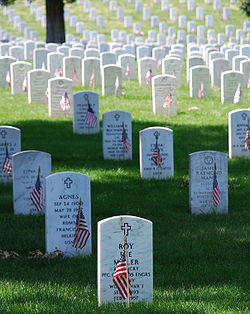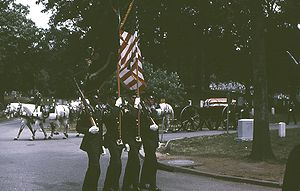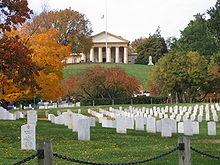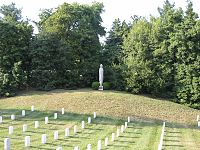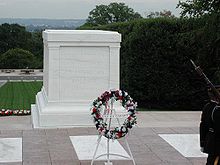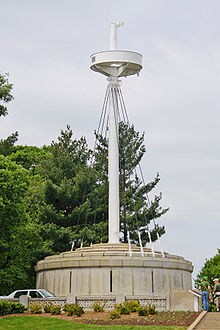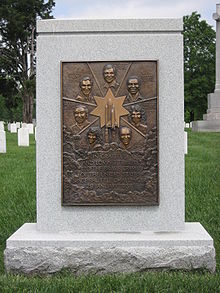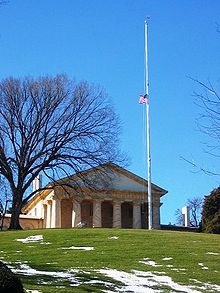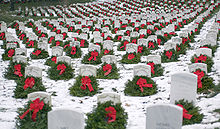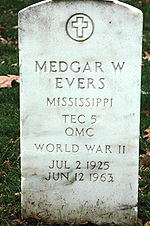- Arlington National Cemetery
-
For Arlington Cemetery in Pennsylvania, see Arlington Cemetery Co.
Arlington National Cemetery
The gravestones at Arlington National Cemetery are marked by U.S. flags each Memorial Day.Details Year established June 28, 1864 Country United States Location Arlington County, Virginia Coordinates 38°52′37″N 77°04′15″W / 38.876806°N 77.070795°WCoordinates: 38°52′37″N 77°04′15″W / 38.876806°N 77.070795°W Type Public Owned by United States Department of the Army Size 624 acres (2.5 km2) Number of graves 300,000 Website Official Site Find a Grave Findagrave Arlington National Cemetery in Arlington County, Virginia, is a military cemetery in the United States of America, established during the American Civil War on the grounds of Arlington House, formerly the estate of the family of Confederate general Robert E. Lee's wife Mary Anna (Custis) Lee, a great grand-daughter of Martha Washington. The cemetery is situated directly across the Potomac River from the Lincoln Memorial in Washington, D.C. It is served by the Arlington Cemetery station on the Blue Line of the Washington Metro system.
In an area of 624 acres (2.53 km2), veterans and military casualties from each of the nation's wars are interred in the cemetery, ranging from the American Civil War through to the military actions in Afghanistan and Iraq. Pre-Civil War dead were reinterred after 1900.
Arlington National Cemetery and United States Soldiers' and Airmen's Home National Cemetery are administered by the Department of the Army. The other national cemeteries are administered by the Department of Veterans Affairs or by the National Park Service. Arlington House (Custis-Lee Mansion) and its grounds are administered by the National Park Service as a memorial to Lee.
History
George Washington Parke Custis, grandson of Martha Washington, acquired the land that now is Arlington National Cemetery in 1802, and began construction of Arlington House. The estate passed to Custis' and his wife's (Mary Lee Fitzhugh Custis) only surviving adult child Mary Anna Custis Lee[not in citation given][1] who was married to Robert E. Lee, a West Point graduate and United States Army officer. When Fort Sumter was forced to surrender at the beginning of the American Civil War, President Abraham Lincoln offered Lee command of the federal army. Lee demurred, waiting to see if his native Virginia would decide to secede.
When Virginia announced its decision, Lee resigned his commission and took command of the armed forces of the Commonwealth of Virginia, later becoming commander of the Army of Northern Virginia.[2] He quickly established himself as an able commander, defeating a series of Union generals, until his final defeat and surrender at the McLean House. Because of this decision and subsequent performance, Lee was regarded as disloyal by most Union officers. The decision was made to appropriate a portion of Arlington as a graveyard primarily for Union dead.[3]
American military cemeteries developed from the duty of commanders on the frontier and in battle to care for their casualties. When Civil War casualties overflowed hospitals and burial grounds near Washington, D.C., Quartermaster General Montgomery C. Meigs proposed in 1864 that 200 acres (81 ha) of the Robert E. Lee family property at Arlington be confiscated for a cemetery.
The government acquired Arlington at tax sale in 1864 for $26,800, equal to $375,086 today.[4] Mrs. Lee had not appeared in person, but rather had sent an agent, attempting to timely pay the $92.07 in property taxes (equal to $1,288.59 today) assessed the estate.[5] The government turned away her agent, refusing to accept the tendered payment. In 1874, Custis Lee, heir under his grandfather's will passing the estate in trust to his mother, sued the United States claiming ownership of Arlington. After the U.S. Supreme Court ruled 5-4 in Lee's favor in United States v. Lee, deciding that Arlington had been confiscated without due process,[5] Congress returned the estate to him. The next year, Custis Lee sold it back to the government for $150,000 (equal to $2,990,000 today) at a signing ceremony with Secretary of War Robert Todd Lincoln.[4]
Military burials were previously held at the United States Soldiers' National Cemetery in Washington, D.C., but it was quickly filling.[4] "We pray for those who lost their lives," Meigs wrote, "The grounds about the mansion are admirably adapted to such a use." Burials had, in fact, begun at Arlington before the ink was even blotted on Meigs's proposal.
The southern portion of the land now occupied by the cemetery was used during and after the Civil War as a settlement for freed slaves. More than 1,100 freed slaves were given land at Freedman's Village by the government, where they farmed and lived during and after the Civil War. They were evicted in 1888 when the estate was repurchased by the government and dedicated as a military installation.
President Herbert Hoover conducted the first national Memorial Day ceremony in Arlington National Cemetery, on May 30, 1929.[6]
Sections
Arlington National Cemetery is divided into 70 sections, with some sections in the southeast portion of the cemetery reserved for future expansion.[7] Section 60, in the southeast part of the cemetery, is the burial ground for military personnel killed in the Iraq War and the War in Afghanistan.[8] In 2005, Arlington National Cemetery acquired 12 acres (4.9 ha) of additional land from the National Park Service, along with 17 acres (6.9 ha) from the Department of Defense that was part of Fort Myer and 44 acres (18 ha) that is the site of the Navy Annex.[9]
Section 21, also known as the Nurses Section, is the area of Arlington National Cemetery where many nurses are buried and is the site of the Nurses Memorial.[10] Another section—Chaplains Hill—includes monuments to Jewish, Protestant, and Roman Catholic military chaplains. In 1901, Confederate soldiers buried at the Soldiers' Home and various locations within Arlington were reinterred in a Confederate section that was authorized by Congress in 1900. On June 4, 1914, the United Daughters of the Confederacy dedicated a monument designed by Moses Ezekiel. Upon his death in 1917, Ezekiel was buried at the base of the monument as he was a veteran of the Confederate army.[11] All Confederate headstones in this section are peaked rather than rounded.[12] More than 3,800 former slaves, called "Contrabands" during the Civil War, are buried in Section 27. Their headstones are designated with the word "Civilian" or "Citizen".[13]
Grave markers, niches and headstones
The United States Department of Veterans Affairs oversees the National Cemetery Administration's orders[14] for placement of inscriptions and faith emblems at no charge to the estate of the deceased, submitted with information provided by the next of kin[15] that is placed on upright marble headstones or columbarium niche covers. The Department of Veterans Affairs currently offers 39 authorized faith emblems for placement on markers to represent the deceased's faith.[16][17] This number has grown in recent years due to legal challenges to policy.[18]
Prior to 2007, the United States Department of Veterans Affairs (VA) did not allow the use of the pentacle as an "emblem of belief" on tombstones in military cemeteries. This policy was changed following an out-of-court settlement on 23 April following a series of lawsuits against the VA.[19][20][21] See Patrick Stewart.
Between 1947 and 2001, privately-purchased markers were permitted in the cemetery, but the areas in which the cemetery permitted such markers are now filled.[22] Nevertheless, the older sections of the cemetery have a wide variety of private markers placed prior to 2001, including artillery pieces.[23]
Tomb of the Unknowns
Main article: Tomb of the UnknownsThe Tomb of the Unknowns at Arlington National Cemetery is also known as the Tomb of the Unknown Soldier. It stands on top of a hill overlooking Washington, D.C.
One of the more popular sites at the Cemetery, the tomb is made from Yule marble quarried in Colorado. It consists of seven pieces, with a total weight of 79 short tons (72 metric tons). The tomb was completed and opened to the public April 9, 1932, at a cost of $48,000.
It was initially named the "Tomb of the Unknown Soldier." Other unknown servicemen were later entombed there, and it became known as the "Tomb of the Unknowns", though it has never been officially named. The soldiers entombed there are:
- Unknown Soldier of World War I, interred November 11, 1921. President Warren G. Harding presided.
- Unknown Soldier of World War II, interred May 30, 1958. President Dwight D. Eisenhower presided.
- Unknown Soldier of the Korean War, also interred May 30, 1958. President Dwight Eisenhower presided again, Vice President Richard Nixon acted as next of kin.
- Unknown Soldier of the Vietnam War, interred May 28, 1984. President Ronald Reagan presided. The remains of the Vietnam Unknown were disinterred, under the authority of President Bill Clinton, on May 14, 1998, and were identified as those of Air Force 1st Lt. Michael J. Blassie, whose family had him re interred near their home in St. Louis, Missouri. It has been determined that the crypt at the Tomb of the Unknowns that contained the remains of the Vietnam Unknown will remain empty.
The Tomb of the Unknowns has been perpetually guarded since July 2, 1937, by the U.S. Army. The 3rd U.S. Infantry Regiment ("The Old Guard") began guarding the Tomb April 6, 1948.
Arlington Memorial Amphitheater
Main article: Arlington Memorial AmphitheaterThe Tomb of the Unknowns is part of the Arlington Memorial Amphitheater. The Memorial Amphitheater has hosted state funerals and Memorial Day and Veterans Day ceremonies. Ceremonies are also held for Easter. About 5,000 people attend these holiday ceremonies each year. The structure is mostly built of Imperial Danby marble from Vermont. The Memorial Display room, between the amphitheater and the Tomb of the Unknowns, uses Botticino stone, imported from Italy. The amphitheater was the result of a campaign by Ivory Kimball to construct a place to honor America's soldiers. Congress authorized the structure March 4, 1913. Woodrow Wilson laid the cornerstone for the building on October 15, 1915. The cornerstone contained 15 items including a Bible and a copy of the Constitution.[24]
Before the Arlington Memorial Amphitheater was completed in 1921, important ceremonies were held at what is now known as the "Old Amphitheater." This structure sits where Robert E. Lee once had his gardens. The amphitheater was built in 1868 under the direction of General John A. Logan. Gen. James A. Garfield was the featured speaker at the Decoration Day dedication ceremony, May 30, 1868. The amphitheater has an encircling colonnade with a latticed roof that once supported a web of vines. The amphitheater has a marble dais, known as "the rostrum", which is inscribed with the U.S. national motto found on the Great Seal of the United States, E pluribus unum ("Out of many, one"). The amphitheater seats 1,500 people and has hosted speakers such as William Jennings Bryan.[25]
Memorials
Memorial above cremated unidentified remains honoring the crew of the Space Shuttle Challenger
Due to the ever-decreasing space at the cemetery, and that the nature of memorials is to take up space that could otherwise be used to bury an eligible servicemember, the army requires a joint or concurrent resolution from Congress before it will place new memorials on cemetery grounds. Still, there are several memorials on cemetery grounds, and groups regularly seek to use the ever-diminishing grounds for new memorials.
Near the Tomb of the Unknowns stands a memorial to the 266 men who lost their lives aboard the USS Maine. The memorial is built around a mast salvaged from the Maine’s wreckage.[26] The USS Maine Memorial served as the temporary resting place for foreign heads of state or government, Manuel L. Quezon of the Philippines and Ignacy Jan Paderewski of Poland, who died in exile in the United States during World War II.
The Space Shuttle Challenger Memorial was dedicated on May 20, 1986, in memory of the crew of flight STS-51-L, who died during launch on January 28, 1986. Transcribed on the back of the stone is the text of the John Gillespie Magee, Jr. poem High Flight. Although many remains were identified and returned to the families for private burial, some were not, and were laid to rest under the marker. Two crew members, Scobee and Smith, are buried in Arlington. On February 1, 2004, NASA Administrator Sean O'Keefe dedicated a similar memorial to those who died when the Shuttle Columbia broke apart during reentry on February 1, 2003.[27] Astronauts Laurel Clark, David Brown and Michael Anderson, who were killed in the Columbia disaster, are also buried in Arlington.
On a knoll just south of Arlington House, with views of the Washington Monument and Capitol, is a memorial to Pierre Charles L'Enfant, the architect who laid out the city of Washington. His remains lie below a marble memorial incised with his plan for the city. L'Enfant envisioned a grand neoclassical capital city for the young republic that would rival the capitals of European monarchies.
The Cairn, the Lockerbie memorial[28] is a memorial to the 270 killed in the bombing of Pan Am Flight 103 over Lockerbie, Scotland. The memorial is constructed of 270 stones, one for each person killed in the disaster. In section 64, a memorial to the 184 victims of the September 11 attacks on the Pentagon was dedicated September 11, 2002. The memorial takes the shape of a pentagon, and lists the names of all the victims that were killed and unidentified remains of victims.[29]
The noted composer, arranger, trombonist and big band leader Maj. Alton Glenn Miller of the U.S. Army Air Forces has been missing in action since December 15, 1944. Miller was eligible for a memorial headstone in Arlington National Cemetery as a service member who died on active duty whose remains were not recoverable. At his daughter's request, a stone was placed in Memorial Section H, Number 464-A on Wilson Drive in Arlington National Cemetery in April 1992.
Only two mausoleums located within the confines of the cemetery. One holds the family of General Nelson Appleton Miles. The other, in Section 1, belongs to the family of General Thomas Crook Sullivan.
On June 25, 1925, President Calvin Coolidge approved a request to erect a Commonwealth Cross of Sacrifice with the names of all the citizens of the USA who lost their lives fighting in the Canadian forces during World War I. The monument was dedicated November 11, 1927 and after the Korean War and World War II the names of US citizens who died in those conflicts were added.
The Women in Military Service for America Memorial is adjacent to the Ceremonial Entrance to Arlington National Cemetery.
On May 15, 1997, after more than two decades of denying the existence of the "Secret War" in Laos during the Vietnam War conflict, the U.S. government officially acknowledged this once covert war, honoring its U.S. and Laos Hmong veterans with the opening of the Laos Memorial on the Arlington National Cemetery grounds, along a path between the John F. Kennedy Eternal Flame and the Tomb of the Unknowns.
Burial procedures
Arlington House flag flying at half-staff. The flag is lowered during interments.
The flags in Arlington National Cemetery are flown at half-staff from a half hour before the first funeral until a half hour after the last funeral each day. Funerals are normally conducted five days a week, excluding weekends.[30][31]
Funerals, including interments and inurnments, average between 27-30 per day. The cemetery conducts approximately 6,900 burials each year.[13]
With more than 300,000 interments, Arlington National Cemetery has the second-largest number of burials of any national cemetery in the United States. The largest of the 130 national cemeteries is the Calverton National Cemetery, on Long Island, near Riverhead, New York, which conducts more than 7,000 burials each year.
In addition to in-ground burial, Arlington National Cemetery also has one of the larger columbaria for cremated remains in the country. Four courts are currently in use, each with 5,000 niches. When construction is complete, there will be nine courts with a total of 50,000 niches; capacity for 100,000 remains. Any honorably discharged veteran is eligible for inurnment in the columbarium, if s/he served on active duty at some point in her/his career (other than for training).[32]
Burial criteria
Part 553 of Title 32 of the Code of Federal Regulations establishes regulations for Arlington National Cemetery, including eligibility for interment (ground burial) and inurnment (columbarium). Eligibility for burial differs from eligibility for inurnment in the columbarium at Arlington National Cemetery. Due to limited space, ground burial eligibility criteria are more restrictive than at other national cemeteries, as well as more restrictive than inurnment in the columbarium.
The persons specified below are eligible for ground burial in Arlington National Cemetery, unless otherwise prohibited.[33] The last period of active duty of former members of the armed forces must have ended honorably. Interment may be of casketed or cremated remains.
- Any active-duty member of the armed forces (except those members serving on active duty for training only).
- Any veteran who is retired and eligible for retirement pay from service in the armed forces (including service members retired from a reserve component who served a period of active duty (other than for training).
- Any former member of the armed forces separated honorably prior to October 1, 1949, for medical reasons and who was rated at 30% or greater disabled effective on the day of discharge.
- Any former member of the armed forces who has been awarded one of the following decorations:
- Individuals awarded the Central Intelligence Agency's (CIA) Intelligence Star, which is considered the equivalent of the US Military's Silver Star and recognized as such by the President of the United States.[34]
- The President of the United States or any former President of the United States[citation needed].
- Any former member of the armed forces who served on active duty (other than for training) and who held any of the following positions:
- An elective office of the U.S. Government (such as a term in Congress).
- Office of the Chief Justice of the United States or of an Associate Justice of the Supreme Court of the United States.
- An office listed, at the time the person held the position, in 5 USC 5312 or 5313 (Levels I and II of the Executive Schedule).
- The chief of a mission who was at any time during his/her tenure classified in Class I under the provisions of Section 411, Act of 13 August 1946, 60 Stat. 1002, as amended (22 USC 866) or as listed in State Department memorandum dated March 21, 1988.
- Any former prisoner of war who, while a prisoner of war, served honorably in the active military, naval, or air service, whose last period of military, naval or air service terminated honorably and who died on or after November 30, 1993.
- The spouse, widow or widower, minor child, or permanently dependent child, and certain unmarried adult children of any of the above eligible veterans.
- The widow or widower of:
- a member of the armed forces who was lost or buried at sea or fell out of a plane or officially determined to be permanently absent with a status of either missing or missing in action.
- a member of the armed forces who is interred in a US military cemetery overseas that is maintained by the American Battle Monuments Commission.
- The spouse, minor child, or permanently dependent child of any person already buried in Arlington National Cemetery.
- The parents of a minor child, or permanently dependent child whose remains, based on the eligibility of a parent, are already buried at Arlington. A spouse divorced from the primary eligible, or widowed and remarried, is not eligible for interment.
- Provided certain conditions are met, a former member of the armed forces may be buried in the same grave with a close relative who is already buried and is the primary eligible.
Inurnment Criteria for Columbarium
Due at least partly to the lack of space at the cemetery for ground burial, standards for inurnment (burial of cremated remains) in the columbarium are currently much less restrictive than for ground burial at the Cemetery. In general, any former member of the armed forces who served on active duty (other than for training) and whose last service terminated honorably is eligible for inurnment. Eligiblity for inurnment is described fully in 32 C.F.R. § 553.15a.
Prohibitions Against Interment or Memorialization
Congress has from time to time created prohibited categories of persons that, even if otherwise eligible for burial, lose that eligibility. One such prohibition is against certain persons who are convicted of committing certain state or federal capital crimes, as defined in 38 U.S. Code § 2411. Capital crime is a specifically defined term in the statute, and for state offenses can include offenses that are eligible for a life sentence (with or without parole). The reasoning for this provision originally was to prevent Timothy McVeigh from being eligible at Arlington National Cemetery, but it has since been amended to prevent others.[35]
Also prohibited under the same statute are those determined, with clear and convincing evidence, to have avoided such conviction by death or flight.
Notable burials
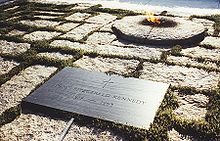 Eternal flame and marker at the grave of John F. Kennedy, 35th president of the United States, as it appeared prior to the parallel interment of his widow, Jacqueline Kennedy, upon her death.
Eternal flame and marker at the grave of John F. Kennedy, 35th president of the United States, as it appeared prior to the parallel interment of his widow, Jacqueline Kennedy, upon her death.
The first soldier to be buried in Arlington was Private William Henry Christman of Pennsylvania on May 13, 1864.[36] As of May 2006, there were 367 Medal of Honor recipients buried in Arlington National Cemetery,[37] nine of whom are Canadian.
Four state funerals have been held at Arlington: those of Presidents William Howard Taft and John F. Kennedy, that of General John J. Pershing, and that of U.S. Senator Edward M. Kennedy. Whether or not they were wartime service members, U.S. presidents are eligible to be buried at Arlington, since they oversaw the armed forces as commanders-in-chief.
Among the most frequently visited sites in the cemetery is the grave of President John F. Kennedy, who is buried with his wife, Jacqueline, and two of their children. His remains were interred there on March 14, 1967, a reinterment from his original Arlington burial site, some 20 feet (6.1 m) away, where he was buried in November 1963. The grave is marked with the "eternal flame". The remains of his brothers, Senator Robert F. Kennedy and Senator Edward M. "Ted" Kennedy, are buried nearby. The latter two graves are marked with simple crosses and footstones. On December 1, 1971, Robert Kennedy's body was reinterred 100 feet (30 m) from its original June 1968 burial site.
Burial under protest
Warrant Officer Gregory S. Crandall's helicopter was shot down over Savannakhet Province, Laos, on February 18, 1971. In May of that year the military listed him as Killed in action (KIA). According to Arlington National Cemetery records, John Manning, chief of the Army's Mortuary Affairs Branch, stated that witnesses to the crash reported that the "helicopter burst into flames and exploded when it hit the ground." It was also reported that there were a series of seven explosions. The remains of Crandall and two other soldiers were recovered in February 1991, and on September 17, 1993, despite the protest of the family, a full-size steel casket, the remains of Warrant Officer Gregory S. Crandall, which consisted of a single No. 4 maxillary premolar tooth, was buried with full military honors.[38]
Grave marker of slain civil rights leader Medgar Evers.
Media access controversy
For more details on this topic, see Arlington National Cemetery mismanagement controversy#Media access controversy and termination.Until 2005, the cemetery's administration gave free access, with the family's permission, to the media to cover funerals at the cemetery. According to the Washington Post, over the past several years the cemetery has gradually imposed increasing restrictions on media coverage of funerals.[39]
2010 mismanagement controversy
Main article: Arlington National Cemetery mismanagement controversyOn June 9, 2010, United States Secretary of the Army John M. McHugh reprimanded Arlington National Cemetery's superintendent, John Metzler, and his deputy, Thurman Higgenbotham, after a United States Department of Defense inspector general's report revealed that cemetery officials had placed the wrong headstones on tombs, buried coffins in shallow graves, and buried bodies on top of one another.[40] Metzler, who had already announced his intention to retire on July 2, 2010, admitted some mistakes had been made but denied allegations of widespread or serious mismanagement.[40] The investigation also found that cemetery employees were burdened in their day-to-day work by "dysfunctional management, lack of established policy and procedures, and an overall unhealthy organizational climate."[41][42] Both Metzler and Higgenbotham retired soon after the investigation commenced.[43]
In March 2011, as a result of the problems discovered, Kathryn Condon, the recently appointed director of the Army Cemeteries Program, announced that the cemetery's staff had been increased from 102 to 159. She added that the cemetery was also acquiring additional equipment because, "They didn't have the proper equipment to do the job really to the standard they needed to do."[44]
See also
- Laos Memorial
- McKee Grave
- Netherlands Carillon
- Victims of Terrorist Attack on the Pentagon Memorial
- Theodore Wint Grave
- William Belknap Grave
- List of National Cemeteries by country
References
- ^ Karl Decker and Angus McSween (1892). Historic Arlington. Washington: Decker and McSween Publishing Company. p. 80. http://www.archive.org/stream/historicarlingto00deckrich/historicarlingto00deckrich_djvu.txt. Retrieved 2011-07-31. "Neither Gen. Lee nor his wife, Mary Custis Lee, made any attempt to regain possession of the Arlington property. They were but life tenants and had no title to the property, which had been devised by George Washington Parke Custis to his grandson"
- ^ Ezra J. Warner (1959). Generals in Gray. Baton Rouge: Louisiana State University Press. p. 181. ISBN 978-0807108239.
- ^ The Civil War: An Illustrated History, Geoffrey Ward, with Ken and Rick Burns. 2045. ISBN 0-679-74277-8.
- ^ a b c Hughes, Mark (1995). Bivouac of the Dead. Heritage Books. pp. 265. ISBN 978-0788402609.
- ^ a b Arlingtoncemetery.org "Historical Information". Arlington National Cemetery. http://www.arlingtoncemetery.org/historical_information/arlington_house.html Arlingtoncemetery.org. Retrieved 2011-07-29.
- ^ John T. Wolley and Gerhard Peters. "Herbert Hoover: Memorial Day Address at Arlington National Cemetery". The American Presidency Project [online]. http://www.presidency.ucsb.edu/ws/index.php?pid=22129. Retrieved 2010-05-26.
- ^ "Interactive Map". Arlington National Cemetery. http://www.arlingtoncemetery.org/interactive_map/interactivemap_big.html. Retrieved 2009-08-05.
- ^ "Mementos adorn 'saddest acre'". CNN. 2009-05-23. http://edition.cnn.com/2009/US/05/23/section.60.cemetery/index.html. Retrieved 2009-08-05.
- ^ Williams, Rudi (27 May 2005). "Arlington National Cemetery Gains 70 Acres of Land". American Forces Press Service. http://www.defenselink.mil/news/newsarticle.aspx?id=31562. Retrieved 2009-08-05.
- ^ "Nurses Memorial". Arlington National Cemetery. http://www.arlingtoncemetery.org/text/nurses_memorial_text.html. Retrieved 2009-08-05.
- ^ "Confederate Memorial". Arlington National Cemetery. http://www.arlingtoncemetery.org/visitor_information/Confederate_Memorial.html. Retrieved 2009-08-05.
- ^ "History of Government Furnished Headstones and Markers". Department of Veterans Affairs. 1 February 2010. http://www.cem.va.gov/hist/hmhist.asp. Retrieved 2011-07-29.
- ^ a b "Arlington National Cemetery Facts". Arlington National Cemetery. http://www.arlingtoncemetery.org/visitor_information/anc_facts.html. Retrieved 2011-07-29.
- ^ "Ordering a Headstone or Marker". Department of Veterans Affairs. http://www.cem.va.gov/hm/hmorder.asp. Retrieved 2011-07-29.
- ^ "Application for Standard Government Headstone or Marker for Installation Cemetery or State Veterans' Cemetery". Department of Veterans Affairs. August 2009. http://www.va.gov/vaforms/va/pdf/VA40-1330.pdf. Retrieved 2011-07-29.
- ^ "Authorized Emblems". Arlington National Cemetery. http://www.arlingtoncemetery.org/funeral_information/authorized_emblems.html. Retrieved 2011-07-29.
- ^ "Available Emblems of Belief for Placement on Government Headstones and Markers". Department of Veterans Affairs. 16 May 2011. http://www.cem.va.gov/hm/hmemb.asp. Retrieved 2011-07-29.
- ^ "Veterans Denied Right to Post Religious Symbol on Headstones, ACLU Charges" (Press release). American Civil Liberties Union. 29 September 2006. http://www.aclu.org/religion-belief/veterans-denied-right-post-religious-symbol-headstones-aclu-charges. Retrieved 2011-07-29.
- ^ Associated Press (2007-04-23). "Wiccans symbols allowed on grave markers in government cemeteries". International Herald Tribune. http://www.iht.com/articles/ap/2007/04/23/america/NA-GEN-US-Wiccan-Soldier.php. Retrieved 2007-07-11.
- ^ "Veterans Affairs Department Must Accommodate Wiccan Symbol On Memorial Markers At Government Cemeteries, Says Americans United" (Press release). Americans United (AU.org). 2006-06-08. http://www.au.org/site/News2?JServSessionIdr003=bg8nm5s6e1.app13a&abbr=pr&page=NewsArticle&id=8269&security=1002&news_iv_ctrl=1241. Retrieved 2007-07-11.
- ^ "Available Emblems of Belief for Placement on Government Headstones and Markers". VA.gov. http://www.cem.va.gov/cem/hm/hmemb.asp. Retrieved 2007-07-11.
- ^ "A Guide to Burial at Arlington National Cemetery—Private Markers". Arlington National Cemetery. http://www.arlingtoncemetery.mil/funeral_information/guide.atneed.html#headstones. Retrieved 2011-07-29.
- ^ "Wallace Fitz Randolph". Arlington National Cemetery Website. 24 September 2009. http://www.arlingtoncemetery.net/wfrandol.htm. Retrieved 2011-07-29.
- ^ Arlingtoncemetery.org "The Memorial Amphitheater at Arlington National Cemetery". Arlington National Cemetery. http://www.arlingtoncemetery.org/visitor_information/amphitheater.html Arlingtoncemetery.org. Retrieved 2011-07-29.
- ^ "Old Amphitheatre". Arlington National Cemetery. http://www.arlingtoncemetery.org/visitor_information/old_amphitheater.html. Retrieved 2011-07-29.
- ^ "U.S.S. Maine Memorial". Arlington National Cemetery Website. 30 June 2008. http://www.arlingtoncemetery.net/ussmaine.htm. Retrieved 2011-07-29.
- ^ "Columbia Memorial Dedicated at Arlington". NASA. http://www.nasa.gov/columbia/home/F_04_Memorials.html. Retrieved 2011-07-29.
- ^ arlingtoncemetery.net "The Lockerbie Memorial Cairn". Arlington National Cemetery Website. 22 April 2009. http://www.arlingtoncemetery.net/cairn.htm arlingtoncemetery.net. Retrieved 2011-07-29.
- ^ Jim Garamone (12 September 2002). "Remains of Pentagon Attack Victims Buried at Arlington". American Forces Press Service (Department of Defense). http://www.defense.gov/news/newsarticle.aspx?id=43465. Retrieved 2011-07-27.
- ^ Location of Arlington House flagpole: 38°52′52″N 77°04′20″W / 38.881187°N 77.072128°W
- ^ Hybrid satellite image/street map from WikiMapia
- ^ "32 CFR 553.15a — Persons eligible for inurnment of cremated remains in Columbarium in Arlington National Cemetery". National Archives and Records Administration. 27 July 2011. http://ecfr.gpoaccess.gov/cgi/t/text/text-idx?c=ecfr;rgn=div8;view=text;node=32%3A3.1.1.4.18.0.11.16;idno=32;cc=ecfr;sid=1b5d76eb98eb266e4144e384e69e930a. Retrieved 2011-07-29.
- ^ "Establishing Eligibility—Eligibility for Interment (Ground Burial)". Arlington National Cemetery. http://www.arlingtoncemetery.org/funeral_information/guide.interment.html. Retrieved 2011-07-29.
- ^ Bush At War, Bob Woodward, Simon and Schuester, 2002, page 317
- ^ Associated Press (10 August 2005). "Arlington National Cemetery Burial Law Eyed". Fox News. http://www.foxnews.com/story/0,2933,165335,00.html. Retrieved 2011-07-29.
- ^ "Arlington National Cemetery Section 27 facts". Arlington National Cemetery. http://www.arlingtoncemetery.org/historical_information/section_27_facts.html. Retrieved 2009-04-25.
- ^ "Medal of Honor Recipients Buried at Arlington National Cemetery". Arlington National Cemetery Website. 6 June 2011. http://www.arlingtoncemetery.net/medalofh.htm. Retrieved 2011-07-29.
- ^ "Gregory Stephen Crandall". Arlington National Cemetery Website. 16 August 2006. http://www.arlingtoncemetery.net/crandall.htm. Retrieved 2011-07-29.
- ^ Dana Milbank (10 July 2008). "Putting Her Foot Down And Getting The Boot". Washington Post (WashingtonPost.com): p. 3. http://www.washingtonpost.com/wp-dyn/content/article/2008/07/09/AR2008070902169.html. Retrieved 2011-07-29.
- ^ a b Julian E. Barnes (11 June 2010). "Arlington National Cemetery's top supervisors ousted in mismanagement case". Los Angeles Times (LATimes.com). http://articles.latimes.com/2010/jun/11/nation/la-na-arlington-cemetery-20100611. Retrieved 2011-07-29.
- ^ William H. McMichael (10 June 2010). "Errors at Arlington affected 211 graves". Military Times (armytimes.com). http://www.armytimes.com/news/2010/06/military_arlington_cemetery_061010w. Retrieved 2011-07-29.
- ^ Associated Press (9 June 2010). "Arlington Cemetery superintendent retiring". Army Times. http://www.armytimes.com/news/2010/06/ap_arlington_cemetery_060910w. Retrieved 2011-07-29.
- ^ Aaron C. Davis (14 July 2010). "Arlington Cemetery's Deputy Chief Retires Amid Investigation". Washington Post (WashingtonPost.com): p. B1. http://www.washingtonpost.com/wp-dyn/content/article/2010/07/13/AR2010071306344.html. Retrieved 2011-07-29.
- ^ Christian Davenport (7 March 2011). "For first time in decades, Arlington National Cemetery must bury multiple 'unknowns'". Washington Post (Washingtonpost.com): p. 1. http://www.washingtonpost.com/wp-dyn/content/article/2011/03/06/AR2011030603633.html. Retrieved 2011-07-29.
Further reading
- Poole, Robert M., On Hallowed Ground: The Story of Arlington National Cemetery, Walker & Co, 2009.
External links
- "Arlington National Cemetery website". http://www.arlingtoncemetery.org/. Retrieved March 11, 2010.
- "National Park Service site". http://www.nps.gov/arho/. Retrieved March 11, 2010.
- "Interment Information". http://www.interment.net/data/us/va/arlington/arlington/. Retrieved March 11, 2010.
- "Fallen Heroes Project on Display at Arlington National Cemetery". http://www.army.mil/-news/2010/01/20/33187-fallen-heroes-project-on-display-at-arlington-cemetery/?ref=news-humaninterest-title2. Retrieved March 11, 2010.
- "Arlington Cemetery: Hallowed Ground". Life magazine. http://www.life.com/image/first/in-gallery/26692/arlington-cemetery-hallowed-ground. Retrieved March 11, 2010.
Categories:- Articles to be expanded with sources
- Protected areas of Arlington County, Virginia
- Arlington National Cemetery
- Cemeteries in Virginia
- United States military memorials and cemeteries
- Burial sites of Presidents of the United States
- Visitor attractions in Arlington County, Virginia
- Monuments and memorials in Virginia
Wikimedia Foundation. 2010.

